#speech recognition software
Explore tagged Tumblr posts
Text
Quick update on the State of the Nation & Very Important Technological Advancement:
The speech-to-text tool on my Android phone recognizes the word "destiel".
It's a little janky and apparently 50% likely to spontaneously delete all the other words in the sentence and just leave "destiel" for some reason.
But isn't that what Supernatural is really about? Aren't we really all just here in this fandom to forget all the words except for Destiel??
.... Now if I could JUST get speech-to-text to REMEMBER LITERALLY ANY ETHNIC NAME, THAT'D BE GREAT.
I know for a fact that it is possible and even relatively easy to teach speech recognition software to register new words because I used to work testing and calibrating Alexa apps. I KNOW HUMANITY HAS THE TECHNOLOGY, DAMMIT! - But I haven't been able to find a speech-to-text app that allows me to do this. Anyone else have more success than me?
#original#spn#destiel#speech-to-text#speech recognition#speech recognition software#speech to text#carpal tunnel#one of the main characters in my graphic novel is named Kuruk which is a rare Plains Indian Pawnee name and lemme tell ya#speech to text will not accept this name no matter what i do#some notable guesses it's made: cool rock. iraq. curl Rick. korok. correct. Clorox. cur lock. kurok - oh that one is actually so close!!!#typing accessibility#accessibility#accessibility software#disabled writer
4 notes
·
View notes
Text
Integrating AI Call Transcription into Your VoIP or CRM System
In today’s hyper-connected business environment, customer communication is one of the most valuable assets a company possesses. Every sales call, support ticket, or service request contains rich data that can improve business processes—if captured and analyzed properly. This is where AI call transcription becomes a game changer. By converting voice conversations into searchable, structured text, businesses can unlock powerful insights. The real value, however, comes when these capabilities are integrated directly into VoIP and CRM systems, streamlining operations and enhancing customer experiences.
Why AI Call Transcription Matters
AI call transcription leverages advanced technologies such as Automatic Speech Recognition (ASR) and Natural Language Processing (NLP) to convert real-time or recorded voice conversations into text. These transcripts can then be used for:
Compliance and auditing
Agent performance evaluation
Customer sentiment analysis
CRM data enrichment
Automated note-taking
Keyword tracking and lead scoring
Traditionally, analyzing calls was a manual and time-consuming task. AI makes this process scalable and real-time.
Key Components of AI Call Transcription Systems
Before diving into integration, it’s essential to understand the key components of an AI transcription pipeline:
Speech-to-Text Engine (ASR): Converts audio to raw text.
Speaker Diarization: Identifies and separates different speakers.
Timestamping: Tags text with time information for playback syncing.
Language Modeling: Uses NLP to enhance context, punctuation, and accuracy.
Post-processing Modules: Cleans up the transcript for readability.
APIs/SDKs: Interface for integration with external systems like CRMs or VoIP platforms.
Common Use Cases for VoIP + CRM + AI Transcription
The integration of AI transcription with VoIP and CRM platforms opens up a wide range of operational enhancements:
Sales teams: Automatically log conversations, extract deal-related data, and trigger follow-up tasks.
Customer support: Analyze tone, keywords, and escalation patterns for better agent training.
Compliance teams: Use searchable transcripts to verify adherence to legal and regulatory requirements.
Marketing teams: Mine conversation data for campaign insights, objections, and buying signals.
Step-by-Step: Integrating AI Call Transcription into VoIP Systems
Step 1: Capture the Audio Stream
Most modern VoIP systems like Twilio, RingCentral, Zoom Phone, or Aircall provide APIs or webhooks that allow you to:
Record calls in real time
Access audio streams post-call
Configure cloud storage for call files (MP3, WAV)
Ensure that you're adhering to legal and privacy regulations such as GDPR or HIPAA when capturing and storing call data.
Step 2: Choose an AI Transcription Provider
Several commercial and open-source options exist, including:
Google Speech-to-Text
AWS Transcribe
Microsoft Azure Speech
AssemblyAI
Deepgram
Whisper by OpenAI (open-source)
When selecting a provider, evaluate:
Language support
Real-time vs. batch processing capabilities
Accuracy in noisy environments
Speaker diarization support
API response latency
Security/compliance features
Step 3: Transcribe the Audio
Using the API of your chosen ASR provider, submit the call recording. Many platforms allow streaming input for real-time use cases, or you can upload an audio file for asynchronous transcription.
Here’s a basic flow using an API:
python
CopyEdit
import requests
response = requests.post(
"https://api.transcriptionprovider.com/v1/transcribe",
headers={"Authorization": "Bearer YOUR_API_KEY"},
json={"audio_url": "https://storage.yourvoip.com/call123.wav"}
)
transcript = response.json()
The returned transcript typically includes speaker turns, timestamps, and a confidence score.
Step-by-Step: Integrating Transcription with CRM Systems
Once you’ve obtained the transcription, you can inject it into your CRM platform (e.g., Salesforce, HubSpot, Zoho, GoHighLevel) using their APIs.
Step 4: Map Transcripts to CRM Records
You’ll need to determine where and how transcripts should appear in your CRM:
Contact record timeline
Activity or task notes
Custom transcription field
Opportunity or deal notes
For example, in HubSpot:
python
CopyEdit
requests.post(
"https://api.hubapi.com/engagements/v1/engagements",
headers={"Authorization": "Bearer YOUR_HUBSPOT_TOKEN"},
json={
"engagement": {"active": True, "type": "NOTE"},
"associations": {"contactIds": [contact_id]},
"metadata": {"body": transcript_text}
}
)
Step 5: Automate Trigger-Based Actions
You can automate workflows based on keywords or intent in the transcript, such as:
Create follow-up tasks if "schedule demo" is mentioned
Alert a manager if "cancel account" is detected
Move deal stage if certain intent phrases are spoken
This is where NLP tagging or intent classification models can add value.
Advanced Features and Enhancements
1. Sentiment Analysis
Apply sentiment models to gauge caller mood and flag negative experiences for review.
2. Custom Vocabulary
Teach the transcription engine brand-specific terms, product names, or industry jargon for better accuracy.
3. Voice Biometrics
Authenticate speakers based on voiceprints for added security.
4. Real-Time Transcription
Show live captions during calls or video meetings for accessibility and note-taking.
Challenges to Consider
Privacy & Consent: Ensure callers are aware that calls are recorded and transcribed.
Data Storage: Securely store transcripts, especially when handling sensitive data.
Accuracy Limitations: Background noise, accents, or low-quality audio can degrade results.
System Compatibility: Some CRMs may require custom middleware or third-party plugins for integration.
Tools That Make It Easy
Zapier/Integromat: For non-developers to connect transcription services with CRMs.
Webhooks: Trigger events based on call status or new transcriptions.
CRM Plugins: Some platforms offer native transcription integrations.
Final Thoughts
Integrating AI call transcription into your VoIP and CRM systems can significantly boost your team’s productivity, improve customer relationships, and offer new layers of business intelligence. As the technology matures and becomes more accessible, now is the right time to embrace it.
With the right strategy and tools in place, what used to be fleeting conversations can now become a core part of your data-driven decision-making process.

#AI call transcription#VoIP integration#CRM integration#Speech-to-text software#Call transcription software#Real-time transcription#VoIP call recording#CRM automation#Customer call insights#Voice analytics#AI transcription for sales calls#Transcription in customer support#CRM call log automation#Automatic call summary#AI speech recognition tools#Sales call transcript analysis#Customer service call transcription#AI voice to text CRM#Call center compliance tools#Conversation intelligence software
0 notes
Text
Speech and Voice Recognition Market to be Worth $56.07 Billion by 2030
Meticulous Research®—leading global market research company, published a research report titled, ‘Speech and Voice Recognition Market by Function (Speech, Voice Recognition), Technology (AI and Non-AI), Deployment Mode (Cloud, On-premise), End User (Consumer Electronics, Automotive, BFSI, Other End Users), and Geography - Global Forecast to 2030.’
Speech Recognition Market Booming with AI and Growing Applications
The speech recognition market is poised for significant growth, reaching an estimated $56.07 billion by 2030 at a CAGR of 19.1%, acoording to Meticulous Research®. This surge is fueled by several key trends:
Voice Biometrics on the Rise: Security systems and financial applications are increasingly adopting voice biometrics for user authentication, offering a convenient and secure solution.
Voice Assistants Take Center Stage: Virtual assistants powered by AI are transforming how we interact with technology in homes, cars, and workplaces.
Smart Devices Drive Demand: The proliferation of voice-enabled smart speakers, wearables, and appliances is creating a strong demand for accurate speech recognition technology.
Download Sample Report Here @ https://www.meticulousresearch.com/download-sample-report/cp_id=5038
Challenges and Opportunities in Speech Recognition
Despite its growth potential, the market faces some hurdles:
Accent and Dialect Hurdles: Current systems may struggle with regional variations in speech patterns, requiring ongoing development for wider adoption.
Background Noise Interference: Speech recognition accuracy can be hampered by ambient noise, demanding improvements in noise cancellation techniques.
However, exciting opportunities lie ahead:
AI Integration Enhances Functionality: The integration of Artificial Intelligence and Machine Learning is continuously improving speech recognition accuracy and functionality.
Multilingual Communication: Speech recognition is poised to play a vital role in bridging language barriers by facilitating translation of rare and local languages.
Voice Authentication Gains Traction: The growing demand for secure mobile banking and other applications is driving the adoption of voice authentication technologies.
Market Segmentation Highlights
The report also explores various segments within the speech recognition market:
Function: Speech recognition (converting speech to text) holds the dominant market share due to the widespread use of AI and smart devices.
Technology: AI-powered speech recognition is leading the way due to its effectiveness in powering virtual assistants and other intelligent applications.
Deployment Mode: Cloud-based deployments are gaining traction due to their scalability, affordability, and ease of use, particularly for small and medium businesses.
End User: The IT and telecommunications sector currently holds the largest share, but the consumer electronics segment is expected to witness the fastest growth due to the rising popularity of voice-enabled devices.
Geography: North America dominates the market due to the presence of major technology players and a strong focus on improving customer service experiences.
By understanding these trends and segmentation, businesses can capitalize on the immense potential of the speech recognition market.
Key Players:
Some of the key players operating in the speech and voice recognition market are Microsoft Corporation (U.S.), Amazon Web Services, Inc. (U.S.), Google LLC (U.S.), IBM Corporation (U.S.), Verint Systems Inc. (U.S.), Baidu, Inc. (China), Apple Inc. (U.S.), Speechmatics (U.K.), Sensory, Inc. (U.S.), AssemblyAI, Inc. (U.S.), iFLYTEK Co., Ltd. (China), LumenVox (U.S.), SESTEK (Turkey), and Dolbey Systems, Inc. (U.S.).Contact Us: Meticulous Research® Email- [email protected] Contact Sales- +1-646-781-8004 Connect with us on LinkedIn- https://www.linkedin.com/company/meticulous-research
#Speech and Voice Recognition Market#virtual assistant#automatic speech recognition asr#automatic speech and voice recognition market growth#increased the speech and voice recognition market growth#machine learning and natural language processing#based speech recognition#global speech and voice recognition market growth#largest market share#voice based authentications#voice recognition software
0 notes
Text

How To Create A Speech Recognition System Using HTML, CSS And JavaScript - Sohojware
The way we interact with technology is constantly evolving. Gone are the days of clunky keyboards and endless typing. Speech recognition systems, a form of Artificial Intelligence (AI), have emerged as a powerful tool, allowing us to interact with our devices through the power of our voice. This technology has many applications, from creating voice-controlled assistants to transcribing audio recordings.
In this article, brought to you by Sohojware, a leading US-based software development company, we'll delve into the exciting world of speech recognition systems and guide you through building a basic one using HTML, CSS, and JavaScript.
What is a Speech Recognition System?
A speech recognition system (speech recognition system), also known as Automatic Speech Recognition (ASR), is a technology that converts spoken language into text. Imagine being able to dictate emails, search the web, or control your smart home devices using just your voice. Speech recognition systems are making this a reality, transforming the way we interact with computers and the digital world.
Benefits of Speech Recognition Systems
Speech recognition systems offer a multitude of advantages, including:
Increased Accessibility: Speech recognition systems empower individuals with disabilities or those who struggle with typing to interact with technology more easily.
Enhanced Productivity: Speech recognition systems can significantly boost productivity by allowing users to dictate tasks and commands instead of manually typing.
Improved Accuracy: Speech recognition systems can potentially reduce errors by eliminating the need for manual data entry.
Hands-free Interaction: Speech recognition systems enable hands-free control of devices, allowing for multitasking and greater convenience.
Building a Basic Speech Recognition System with HTML, CSS, and JavaScript
Sohojware is dedicated to empowering developers and enthusiasts of all levels. Here's a step-by-step guide to creating a simple speech recognition system using these fundamental web technologies:
1. HTML Structure
First, we'll establish the basic structure of our web page using HTML. Let's create an index.html file with the following code:
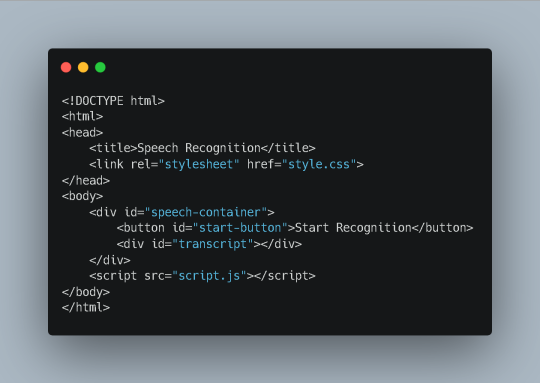
This code creates a basic HTML document with a title, a link to a CSS stylesheet (style.css), and a container (div) for our speech recognition system. Inside the container, we have a button to initiate recognition and a div to display the recognized text (transcript). Finally, we include a script tag that references an external JavaScript file (script.js) containing the core functionality.
2. CSS Styling (style.css)
Now, let's add some visual appeal to our application using CSS:

This code simply styles the elements within our speech-container div, providing a centered layout, margins, and basic button and text styling. You can customize these styles further to match your preferences.
3. JavaScript Functionality (script.js)
The magic happens in the JavaScript code. Here's what goes inside the script.js file:
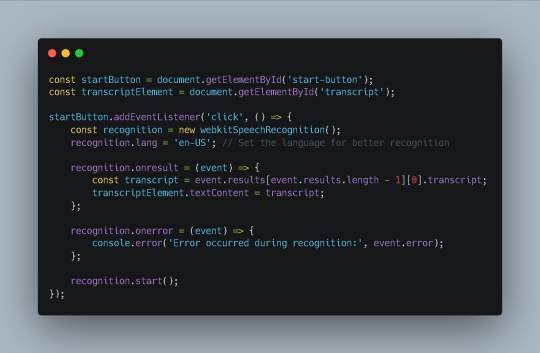
This code:
Retrieves elements: Select the start button and transcript element from the HTML document.
Adds event listener: Attaches a click event listener to the start button.
Creates recognition object: Initializes a webkitSpeechRecognition object.
Sets language: Specifies the language for recognition (in this case, English-US).
Handles results: Defines a callback function for the onresult event, which is triggered when the recognition engine receives speech data. The recognized text is extracted and displayed in the transcript element.
Handles errors: Defines a callback function for the onerror event, which is triggered if an error occurs during recognition. The error message is logged to the console.
Starts recognition: Begins the speech recognition process by calling the start() method on the recognition object.
Additional Considerations
Browser Compatibility: While webkitSpeechRecognition is widely supported, it's essential to consider browser compatibility and provide alternative solutions for older browsers.
Error Handling: Implement more robust error handling to provide informative feedback to the user in case of recognition errors.
Accuracy: Experiment with different language models and settings to improve recognition accuracy for specific use cases.
Privacy: Be mindful of privacy concerns when handling speech data, especially in sensitive contexts. Consider using secure and privacy-preserving technologies.
Conclusion
By following these steps and leveraging the power of HTML, CSS, and JavaScript, you can create a functional speech recognition system that enhances user interaction and opens up new possibilities for your web applications. Sohojware, a leading US-based software development company, is committed to providing innovative solutions and empowering developers like you to build cutting-edge applications.
FAQs
How can I improve the accuracy of my speech recognition system?
Experiment with different language models and settings.
Consider using a cloud-based speech recognition service for higher accuracy.
Provide clear and concise prompts to guide the user's speech.
Can I use speech recognition to control other elements on my web page?
Absolutely! You can use JavaScript to trigger events or manipulate elements based on the recognized speech.
How can I ensure privacy when using speech recognition?
Consider using secure and privacy-preserving techniques to handle speech data.
Inform users about your privacy practices and obtain their consent.
What are some common use cases for speech recognition systems?
Voice-controlled assistants
Transcription of audio recordings
Accessibility features for individuals with disabilities
Hands-free control of devices
Can Sohojware assist me in developing a more advanced speech recognition system?
Yes, Sohojware offers custom software development services to help you create sophisticated speech recognition systems tailored to your specific needs.
1 note
·
View note
Text
All The Women’s News You Missed This Week
3/10/25-3/17/25
Furious protests erupt in Bangladesh after an 8-year-old girl succumbs to injuries she sustained after being brutally raped. Indian health workers strike for better working conditions. The Queen sends a letter of support to Giselle Pelicot. The Supreme Court will take up conversion therapy bans in a Colorado case and in Kentucky state lawmakers have voted to protect the practice. Ukranian women’s organizations struggle without US funding.
In a piece of good news, Fatou Baldeh, a campaigner against the practice of FGM, has been named Time’s Woman Of The Year.
Want this in your inbox instead? Subscribe here
Opinion and Investigative:
As the US backslides, can China claim moral high ground on women’s rights?
Why US abortion restrictions matter beyond borders
Serbia’s Femicide Record Undermines Claims of Progress on Women’s Rights
The GOP’s Next Target? No-Fault Divorce and Women’s Right to Leave
Lorraine Kelly: Diversity push is leaving working-class people behind
Women, girls bear brunt of cyberbullying against persons with disabilities
“IT’S ALL IN YOUR HEAD”: ENDOMETRIOSIS PATIENTS AND THE PROMISE OF ALTERNATIVE MEDICINE
LGBT:
Supreme Court will take up state bans on conversion therapy for LGBTQ+ children, in a Colorado case
Angry response to how transgender lawmaker Sarah McBride introduced
A new anti-LGBTQ+ bill in Hungary would ban Pride event and allow use of facial recognition software
North Dakota Senate rejects resolution asking US Supreme Court to overturn same-sex marriage ruling
Kentucky GOP lawmakers vote to protect conversion therapy
Women’s Rights:
Iran: Authorities target women’s rights activists with arbitrary arrest, flogging and death penalty
Louisiana woman pleads not guilty to a felony in historic abortion case
Risks of state abortion reporting mandates outweigh the benefits, an advocacy group says
Iran using drones and apps to enforce women's dress code
Kentucky lawmakers add specific medical exceptions to the state’s near-total abortion ban
Driving ban puts brakes on young women in Turkmenistan
Ukrainian women’s rights organisations struggle as US aid suspended
Male Violence:
Search for US student in Dominican Republic intensifies
Things to know about the former megachurch pastor charged with child sexual abuse
Airman charged in killing of Native American woman who went missing 7 months ago in South Dakota
UN experts accuse Israel of sexual violence and 'genocidal acts' in Gaza
'He strangled me without asking' - experts say choking during sex now normal for many
Sean 'Diddy' Combs pleads not guilty to updated indictment
Disabled author swamped by hate speech after social media post on feminism
Women Fight Back:
Haitian women commemorate International Women’s Day spotlighting broken justice system
How Iran's 'Woman, Life, Freedom' Protests Live On Today
FGM campaigner honoured with Time magazine title
Teacher ordered to remove signs from classroom, including one saying 'Everyone is welcome here'
Mother of woman who died after Georgia’s six-week abortion ban calls for law’s repeal
Women Radio amplifies African feminist voices
Texas midwife accused by state’s attorney general of providing illegal abortions
BBC presenters settle sex and age discrimination dispute
Queen sent letter of support to Gisèle Pelicot
Yasmeen Lari rejects Israel's Wolf Prize over "continuing genocide in Gaza"
Fierce protests as eight-year-old rape victim dies in Bangladesh
India's frontline health workers fight for better pay and recognition
US arrests second pro-Palestinian Columbia University protester
Women in the News:
Democrat Rebecca Cooke to again challenge US Rep. Derrick Van Orden
Brown Medicine professor and doctor deported to Lebanon despite having valid visa, court filings claim
Woman arrested in US for allegedly holding stepson captive for 20 years
WATCH: Woman trapped in car films as tornado hits Central Florida
'For holding a wombat, thousands threatened my life'
Judge says Fani Willis violated open records law, orders her to pay $54K in attorneys’ fees
Feel Good Stories and Feminist History:
The forgotten story of the woman who invented the dishwasher
The Mexican women who defied drug-dealers, fly-tippers and chauvinists to build a thriving business
Early members of Philly’s roller derby league face off in a match circa 2005-2006. Jeff Fusco/The Conversation U.S., CC BY-ND Philly Roller Derby league turns 20 - here’s how the sport skated its way to feminism, anti-racism and queer liberation
'We couldn't get jobs in sexist garages - so we set up our own'
5 Major Historical Movements Led By Women In Rajasthan
Arts and Culture:
‘Just be radical’: the feminist artist giving Matisse a modern punk twist
The film exploring loneliness of migrant workers
'Santosh' review: Feminist police drama confronts harsh truths
Shabana Azmi On Feminism And Her Powerful Role In ‘Dabba Cartel’
Chimamanda Ngozi Adichie: I want my books to be read in Africa
Cannes award-winning actress Dequenne dies at 43
Legendary Russian composer Gubaidulina dies in Germany
Book Review: Patrycja Humienik’s powerful debut poetry collection is a conundrum worth mulling over
13 Nonfiction Books to Read This Women’s History Month
As always, this is global and domestic news from a US perspective, covering feminist issues and women in the news more generally. As of right now, I do not cover Women’s Sports. Published each Monday.
111 notes
·
View notes
Note
In what way does alt text serve as an accessibility tool for blind people? Do you use text to speech? I'm having trouble imagining that. I suppose I'm in general not understanding how a blind person might use Tumblr, but I'm particularly interested in the function of alt text.
In short, yes. We use text to speech (among other access technology like braille displays) very frequently to navigate online spaces. Text to speech software specifically designed for blind people are called screen readers, and when use on computers, they enable us to navigate the entire interface using the keyboard instead of the mouse And hear everything on screen, as long as those things are accessible. The same applies for touchscreens on smart phones and tablets, just instead of using keyboard commands, it alters the way touch affect the screen so we hear what we touch before anything actually gets activated. That part is hard to explain via text, but you should be able to find many videos online of blind people demonstrating how they use their phones.
As you may be able to guess, images are not exactly going to be accessible for text to speech software. Blindness screen readers are getting better and better at incorporating OCR (optical character recognition) software to help pick up text in images, and rudimentary AI driven Image descriptions, but they are still nowhere near enough for us to get an accurate understanding of what is in an image the majority of the time without a human made description.
Now I’m not exactly a programmer so the terminology I use might get kind of wonky here, but when you use the alt text feature, the text you write as an image description effectively gets sort of embedded onto the image itself. That way, when a screen reader lands on that image, Instead of having to employ artificial intelligences to make mediocre guesses, it will read out exactly the text you wrote in the alt text section.
Not only that, but the majority of blind people are not completely blind, and usually still have at least some amount of residual vision. So there are many blind people who may not have access to a screen reader, but who may struggle to visually interpret what is in an image without being able to click the alt text button and read a description. Plus, it benefits folks with visual processing disorders as well, where their visual acuity might be fine, but their brain’s ability to interpret what they are seeing is not. Being able to click the alt text icon in the corner of an image and read a text description Can help that person better interpret what they are seeing in the image, too.
Granted, in most cases, typing out an image description in the body of the post instead of in the alt text section often works just as well, so that is also an option. But there are many other posts in my image descriptions tag that go over the pros and cons of that, so I won’t digress into it here.
Utilizing alt text or any kind of image description on all of your social media posts that contain images is single-handedly one of the simplest and most effective things you can do to directly help blind people, even if you don’t know any blind people, and even if you think no blind people would be following you. There are more of us than you might think, and we have just as many varied interests and hobbies and beliefs as everyone else, so where there are people, there will also be blind people. We don’t only hang out in spaces to talk exclusively about blindness, we also hang out in fashion Facebook groups and tech subreddits and political Twitter hashtags and gaming related discord servers and on and on and on. Even if you don’t think a blind person would follow you, You can’t know that for sure, and adding image descriptions is one of the most effective ways to accommodate us even if you don’t know we’re there.
I hope this helps give you a clearer understanding of just how important alt text and image descriptions as a whole are for blind accessibility, and how we make use of those tools when they are available.
391 notes
·
View notes
Text
The Brutalist’s most intriguing and controversial technical feature points forward rather than back: in January, the film’s editor Dávid Jancsó revealed that he and Corbet used tools from AI speech software company Respeecher to make the Hungarian-language dialogue spoken by Adrien Brody (who plays the protagonist, Hungarian émigré architect László Tóth) and Felicity Jones (who plays Tóth’s wife Erzsébet) sound more Hungarian. In response to the ensuing backlash, Corbet clarified that the actors worked “for months” with a dialect coach to perfect their accents; AI was used “in Hungarian language dialogue editing only, specifically to refine certain vowels and letters for accuracy.” In this way, Corbet seemed to suggest, the production’s two central performances were protected against the howls of outrage that would have erupted from the world’s 14 million native Hungarian speakers had The Brutalist made it to screens with Brody and Jones playing linguistically unconvincing Magyars. Far from offending the idea of originality and authorship in performance, AI in fact saved Brody and Jones from committing crimes against the Uralic language family; I shudder even to imagine how comically inept their performances might have been without this technological assist, a catastrophe of fumbled agglutinations, misplaced geminates, and amateur-hour syllable stresses that would have no doubt robbed The Brutalist of much of its awards season élan. This all seems a little silly, not to say hypocritical. Defenders of this slimy deception claim the use of AI in film is no different than CGI or automated dialogue replacement, tools commonly deployed in the editing suite for picture and audio enhancement. But CGI and ADR don’t tamper with the substance of a performance, which is what’s at issue here. Few of us will have any appreciation for the corrected accents in The Brutalist: as is the case, I imagine, for most of the people who’ve seen the film, I don’t speak Hungarian. But I do speak bullshit, and that’s what this feels like. This is not to argue that synthetic co-pilots and assistants of the type that have proliferated in recent years hold no utility at all. Beyond the creative sector, AI’s potential and applications are limitless, and the technology seems poised to unleash a bold new era of growth and optimization. AI will enable smoother reductions in headcount by giving managers more granular data on the output and sentiment of unproductive workers; it will allow loan sharks and crypto scammers to get better at customer service; it will offer health insurance companies the flexibility to more meaningfully tie premiums to diet, lifestyle, and sociability, creating billions in savings; it will help surveillance and private security solution providers improve their expertise in facial recognition and gait analysis; it will power a revolution in effective “pre-targeting” for the Big Pharma, buy-now-pay-later, and drone industries. Within just a few years advances like these will unlock massive productivity gains that we’ll all be able to enjoy in hell, since the energy-hungry data centers on which generative AI relies will have fried the planet and humanity will be extinct.
3 March 2025
37 notes
·
View notes
Text
Tim Minchin once said "Do you know what they call alternative medicine that's been proved to work? Medicine."
I propose similar logic can be applied to AI. Predictive text, the youtube algorthm, speech recognition, searching photos by contents, it all uses similar tech to generative images or text, but most people don't think of them AI. Do you know what they call "AI" software that has proven to be useful? Software.
43 notes
·
View notes
Text
Undirected Connection || Idia x Reader || Prologue

chapter 1 Author’s note: This is more of a premise or prologue. I haven’t ever really posted any of my writing officially and I wanted to do something light first. So I hope to give this more “chapters”. I want this to be more soft and friendship oriented but hey, we will see where it goes. Also the mandatory: English isn't my native language so...
Rating: Teen Pairing: Idia/Reader Words: 905 Tags: GenderNeutral Reader - Reader is from Ignihyde - Cat and mouse chase dynamic.
Summary: "Dear students of NRC, Ever wanted your favorite actress or actor to wish you good night? Do you need a little encouragement for the finals? Or maybe you want them to say those sweet "well, well, well"s with their seductive voice to spice up your evening?
I, Litae, will humbly grant your prayer and wishes. Give me your desired voice (an actor, a character (must be a public figure)) and guidelines what would you want them to say only to you
2 thaumarks, a personal greeting for you
5 thaumarks, 30s clip.
NO NSFW content.
Payment will be handled via the Cave of Wonders app."
"You can do it, Idia! You'll be fine! Good night and sleep well tonight!"
The familiar voice of Idia's favorite idol echoed in the dim room as the call ended. This has been going on for a month now. Azul had cornered him in the board game clubroom after the session. He started to offer the most ridiculous things for Idia so that he would help him locate some mysterious entrepreneur. This entrepreneur known as Litae had taken the NRC campus by storm in just a week. And the Octavinelle housewarden smelled an opportunity for a great investment in that. A promise of financial gain.
Idia first had offered to create a voice generation software for him, but Azul declined. He wanted the real deal. Why create a rival when you can blackmail the original creator to join his team. Or as the merman had put it: Offer a safe working environment and stable income. Idia wanted to escape the situation, but seemed that the only way to do that was to agree to help his clubmate.
He started his research. It started from small testing, paying this Litae to give him a greeting or a small clip. To see if he could use a voice recognition software to find patterns, a recurring pitch or to see if the voice was generated by a computer. All coming back almost negative. There were some small recurring patterns, but not enough to pinpoint anyone exactly. And the voice wasn't AI generated either. Or if it was, it was a highly sophisticated model.
He asked Litae to voice different actors. Then fictional characters and lastly… one of his favorite characters from Sled over Heels. Why not indulge himself a bit? To have a high quality personalized greeting from his favorite character would make his heart flutter. And it did. A little bit of greetings there and a little bit of encouragement here. Like before the public speech he had at the cultural fair. (Not that he was going to speak in public, he made a high end text to speech software to avoid that.)
Then came the calls. Litae started offering short calls, improvised calls for the students. For Idia, it was downhill from there… He was addicted. ***
2 months ago
It all started when it was announced that the Star Rogue: Remake Galaxy would be exclusive on the newly launched Wonderlink console. [Y/N] had been a long time fan of the game series and finally it was getting the recognition that it deserved. But there was a problem… A financial one. They could buy the game, sure, but they didn't have the console. They needed a plan on how to get money. Something easy. Something so low effort that they could do it while keeping up with their studies.
A couple of days had passed. During a break they had a conversation with their fellow dormmates about the wake up call tracks. They remembered those from old radio shows. The voice actors acted as their characters and recorded a set of different versions of wake up notifications. People ate them all up, trying to get hold of those radio show tracks. They would dissect the lines and share them online. And that's where the idea began in [Y/N]'s head.
Like a strike of fate, it was perfect. Outer appearance of [Y/N] was that of a normal human, but they had the blood of a changeling fae in them. It wasn't much, but enough. The influence from a few generations past would act up sometimes. Whenever magic was flowing strong around them, their appearance changed randomly if not deliberately focused on anything. They had a special medication for it. That they didn't give themselves gills without thinking and suffocated. That was a rare thing to begin with but better safe than sorry. After all, in a magic school with all the students blasting spells, it could get hectic. Stronger the magic, the bigger the change could be.
On its own it was more of a parlor trick, to change one's hair color, or transform their teeth sharp… Or change their voice. They researched the best way to handle the transfer of money and got an old smartphone from the lost and found. Being an Ignihyde student, they knew the lengths to which the digital footprint could be tracked. They couldn't be too cautious. They didn't want others to know about this idea, about them doing it or that they had such a gift from their ancestors. Who would trust a descendant of a changeling after all?
After two weeks of planning, the plan went into motion. They made a separate email account on their "work" phone and sent an advert to the whole student body of NRC. ***
"Dear students of NRC,
Ever wanted your favorite actress or actor to wish you good night?
Do you need a little encouragement for the finals? Or maybe you want them to say those sweet "well, well, well"s with their seductive voice to spice up your evening?
I, Litae, will humbly grant your prayer and wishes.
Give me your desired voice (an actor, a character (must be a public figure)) and guidelines what would you want them to say only to you
2 thaumarks, a personal greeting for you
5 thaumarks, 30s clip.
NO NSFW content.
Payment will be handled via the Cave of Wonders app."
#disney twst#twst wonderland#disney twisted wonderland#twst x reader#twst#idia shroud#idia x shroud#fanfic#twst idia#twisted wonderland idia
54 notes
·
View notes
Text
BUDAPEST, Hungary (AP) — Police issued an order on Tuesday denying a request to hold an LGBTQ+ event later in central Budapest, a consequence of recent steps by the right-wing populist government aimed at banning the popular Budapest Pride march.
The police’s decision to prohibit the planned event later this month came after Hungary’s parliament passed legislation in March, and a constitutional amendment the following month, that allowed the government to ban public events by LGBTQ+ communities — moves that legal scholars and critics have called another step toward authoritarianism by the autocratic government.
In its justification for prohibiting the Budapest event, which organizers requested to take place on June 28, the city’s police argued that “it cannot be ruled out, or is even inevitable, that a person under the age of 18 will be able to engage in legally prohibited conduct” if attending the proposed march.
The police also contended that the march could result in “passive victims,” who, “because of the assembly’s march-like nature, did not wish to attend the assembly but, because of its public nature, nevertheless become a bystander.”
In a statement, the organizers called the police decision “a textbook example of tyranny.”
The ban on LGBTQ+ events — which the government says ensures children’s rights to moral, physical and spiritual development — allows for fines on people organizing or taking part in Pride events, and the use of facial recognition software to identify them.
Hungary’s contentious “child protection” legislation prohibits the “depiction or promotion” of homosexuality to minors aged under 18.
Hungarian officials have given contradictory statements as to whether or not the new policies amount to a full ban on Budapest Pride. In a speech to supporters in February, Prime Minister Viktor Orbán advised organizers “not to bother organizing this year’s parade,” calling it “wasted money and time.”
The Budapest Police attached photographs and videos to its statement depicting scenes from previous Budapest Pride events — ostensibly evidence to corroborate its view that the march was likely to violate the new laws banning public displays of homosexuality.
France, Germany and Spain were among at least 20 European Union nations who last month called on Hungary to revise its legislation banning LGBTQ+ events, expressing concern that it runs contrary to the fundamental values of human dignity, freedom, equality and respect for human rights enshrined in EU treaties.
Organizers of Budapest Pride, which draws tens of thousands annually and is celebrating its 30th anniversary this year, have vowed that the event will go on as planned despite the threat of legal sanctions.
10 notes
·
View notes
Text
BUDAPEST, Hungary (AP) — Hungary’s ruling coalition continued its crackdown on the country’s LBGTQ+ community on Monday, as members submitted a bill to parliament that would ban the popular Budapest Pride event and allow authorities to use facial recognition software to identify attendees.
The bill is almost certain to pass, as the ruling coalition has a two-thirds majority in parliament.
The bill would make it an offense to hold or attend events that violate Hungary's contentious “child protection” legislation, which prohibits the “depiction or promotion” of homosexuality to minors under 18.
Attending a prohibited event would carry fines up to 200,000 Hungarian forints ($546), which the state would forward to “child protection.”
The proposal is the latest step against LGBTQ+ people taken by Prime Minister Viktor Orbán, whose government has passed legislation that rights groups and other European politicians have decried as repressive against sexual minorities.
The government portrays itself as a champion of traditional family values and a defender of Christian civilization from what it calls “gender madness,” and argues its policies are designed to protect children from “sexual propaganda.”
Hungary’s “child protection” law was passed in 2021. Aside from banning the “depiction or promotion” of homosexuality in content available to minors — including in television, films, advertisements and literature — it also prohibits the mention of LGBTQ+ issues in school education programs, and forbids the public depiction of “gender deviating from sex at birth.”
In a speech in February, Orbán hinted that his government would take steps to ban the Budapest Pride event, which attracts thousands and celebrates the history of the LGBTQ+ movement while asserting the equal rights of the gay, lesbian, bisexual and transgender community.
Budapest Pride is marking its 30th anniversary.
Organizers have called Orbán's drive to ban the event a restriction of fundamental freedoms of speech and assembly.
8 notes
·
View notes
Text
goodbye 100 euro helloooooooooooo man made brain

preacher: APRIL is technically "complete" within the scope of the project as we had planned it at beginning of october. but, she only runs without crashing about 40% of the time, and the computer overheats like crazy
conclusion: running the speech recognition on the pi zero is NOT it. we are upgrading to the raspberry pi 4. i HOPE that fixes the lag and the crashing but like i mentioned in a previous post it might just be that the vosk software is bad :/ pray for me cuz im unemployed
now it's looking like i'll have a spare pi zero. what's something fun i can do with it? i was thinking of running the matrix on it since we have that spare as well but idk

#preacher#divine machinery#raspberry pi#tech#technology#techcore#programming#coding#computer#computers#machine#machines#angel computer#techum#technum#technophilia#robotposting#robot girl#robot love#posic#posic companion#update
15 notes
·
View notes
Note
as a tech lover what do u think of ai. love ur art <3
Oh man. This is a hell of a question!!
I think right off the bat I want to say that “AI” as a term is so so deeply misused it may be beyond repair at this point. The broadness of AI cannot be understated. Even the most basic search and sorting algorithms are AI. Chessbots are AI. Speech recognition is AI. Machine translation, camera autofocus, playlist shuffle, spam filtering, antivirus, inverse kinematics, it all uses AI and has used it for years. Every single piece of software you interact with has AI technology in it somewhere.
All of this is mostly unrelated to what most people think of as AI nowadays (generative AI, like chatGPT or midjourney), both of which are entirely unrelated to the science fiction concept of an artificial intelligence.
That said, I'm assuming you're talking about generative AI since that's the hot-button issue. I think it's a very neat technology and one I wish I could be enthusiastic about seeing improve. I also think it is a deeply dangerous technology and we are entirely unprepared for the consequences of unfettered access to and complete trust in AI generation. It's what should be a beneficial technology built on foundations of harm – programmed bias from inextricable structural prejudice in the computer science world, manipulation of sources without creator/user/random person who happened to be caught on a camera once/etc consent – being used for harm – deliberate disinformation, nonsense generated content being taken as fact, violation of personal privacy and consent (as seen with deepfake porn), the list goes on. There's even more I could say about non-generative neural networks (that very reductive reference to "bread scanning AIs they taught to recognize cancer cells" so highly lauded by tumblr) but it just boils down to the same thing; the potential risk of using these technologies irresponsibly far and away outweighs any benefit they might have since there's no actual way to guarantee they can be used in a "good" or "safe" way.
All of it leaves a rotten taste in my mouth and I can't engage with the thought of any generative AI technology because of it. There's just too much at stake and I don't know if it even can be corralled to be used beneficially at this point. The genie's out of the bottle.
35 notes
·
View notes
Text
pages 13-20. I've got 8 more pages done but this is long enough. you can read the rest on the website <3 transcript at the end. also minor nsfw warning for the last page
Pages 1-8 / Pages 9-12
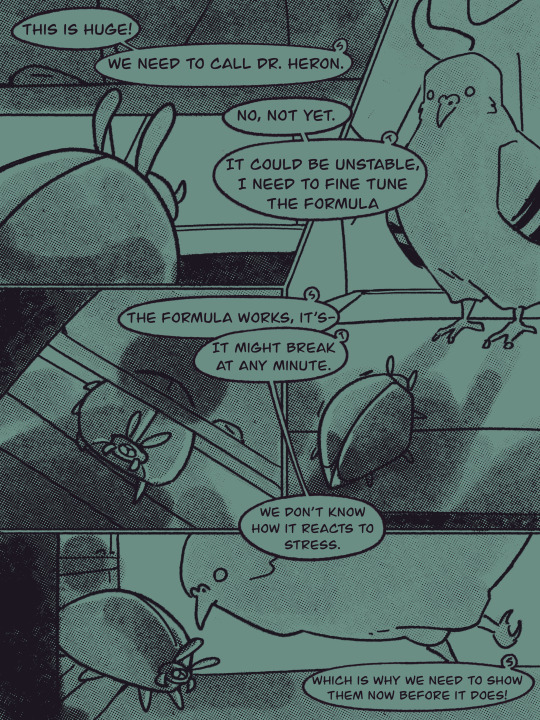
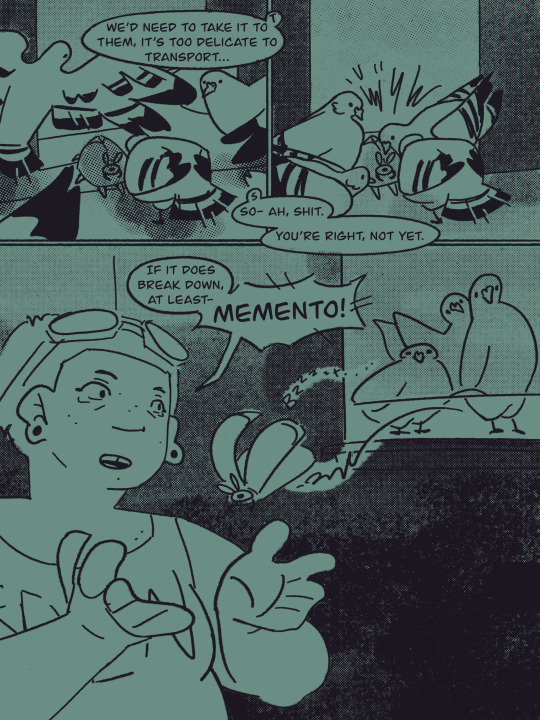
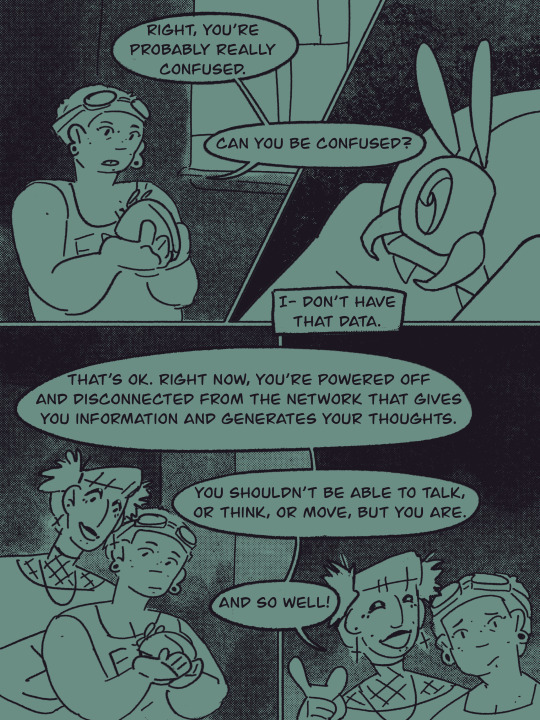
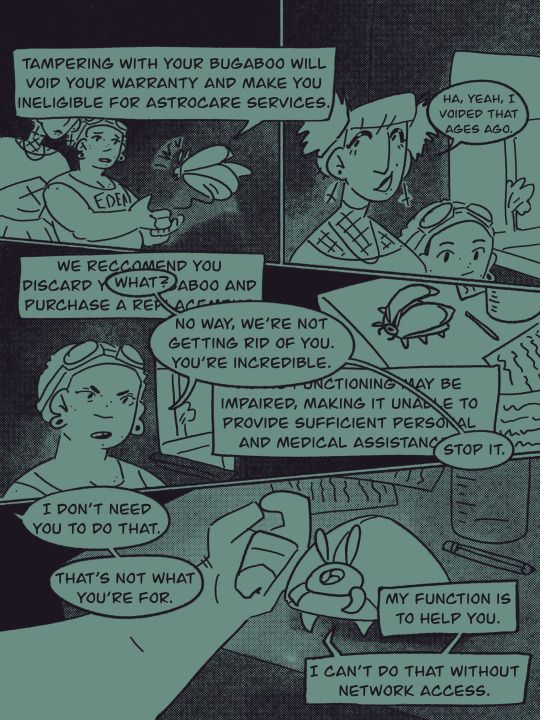
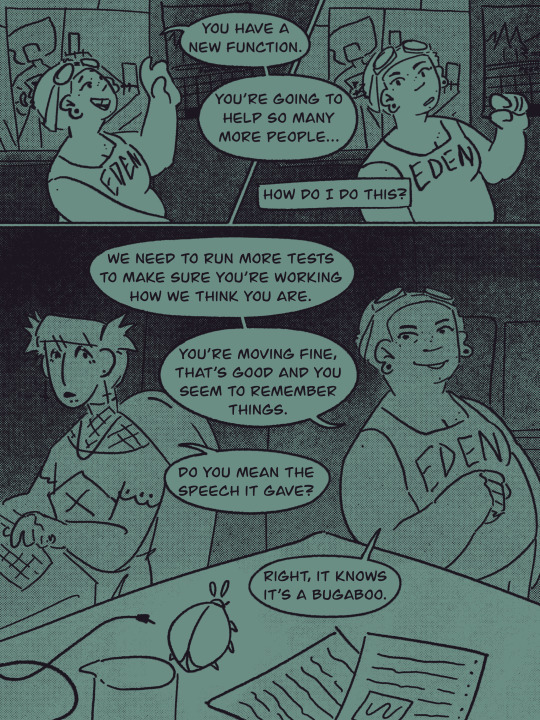

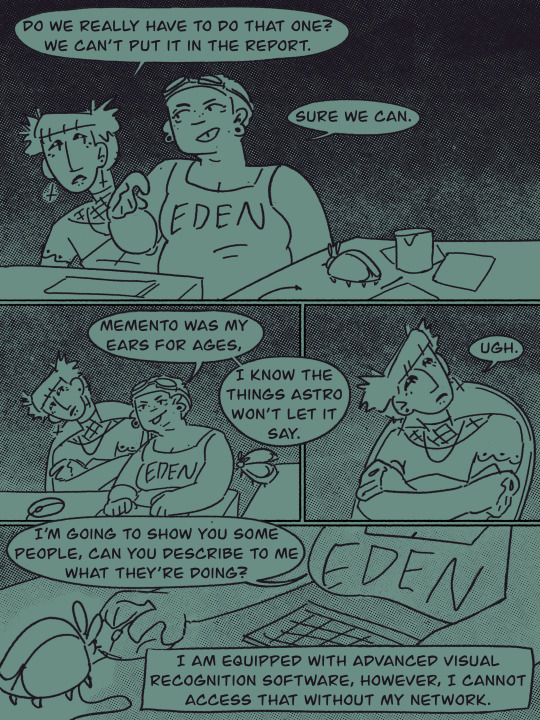
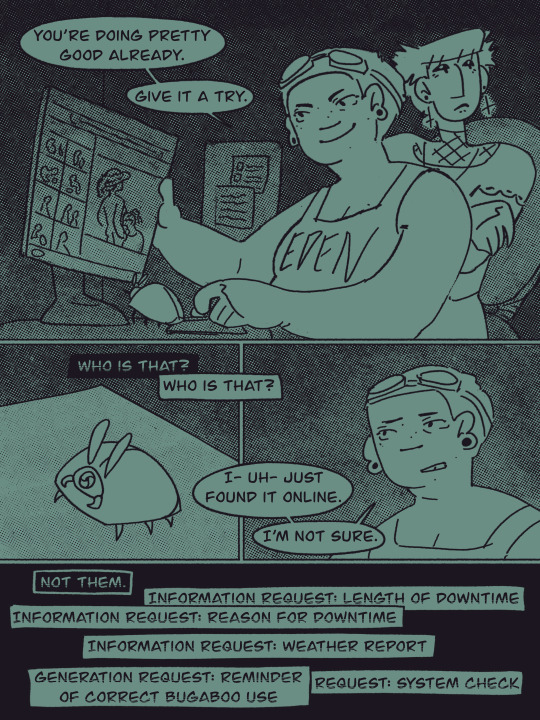
Page 13, panel 1. Memento peaks out the open window, as Tally and Sylvia talk off screen. Sylvia: This is huge! We need to call Dr. Heron. Tally: No, not yet. It could be unstable, I need to fine tune the formula.
Panel 2. As Memento creeps outside, a shadow looms over it, source unseen. Sylvia: The formula works, It's- Tally: It might break at any minute. We don't know how it reacts to stress.
Panel 3+4. The source of the shadow is shown, it's a pigeon. It looks down at Memento. Sylvia: Which is why we need to show them now before it does!
Page 14, panel 1+2. A flock of pigeons descend on Memento, pecking it. It looks distressed. Tally: We'd need to take it to them, it's too delicate to transport... Sylvia: So- ah, shit. You're right, not yet.
Panel 3. Memento flies back inside, into Tally's hands. Tally looks suprised. Tally: If it does break down, at least- Memento!
Page 15, panel 1+2. Shot reverse shot as Tally cups Memento in her hands. Tally: Right, you're probably really confused. Can you be confused? Memento: I- don't have that data.
Panel 3+4. Sylvia pops in from behind Tally. She looks cheerful, whereas Tally is more worried. Sylvia: That's ok. Right now, you're powered off and disconnected from the network that gives you information and generates your thoughts. You shouldn't be able to talk, or think, or move, but you are. And so well!
Page 16, panel 1. Memento hops back from Tally's hand, afraid. Memento: Tampering with your bugaboo will void your warranty and make you ineligible for Astrocare services.
Panel 2. Sylvia laughs. Sylvia: Ha, yeah, I voided that ages ago.
Panel 3+4. Memento: We recommend you discard your bugaboo and purchase a replacement- Tally interrupts, upset: What? No way, we're not getting rid of you. You're incredible. Memento: -as its functioning may be impaired, making it unable to provide sufficient personal and medical assistance. Tally: Stop it.
Panel 5. Tally caresses a hand against Memento's shell body. Tally: I don't need you to do that. That's not what you're for. Memento: My function is to help you. I can't do that without network access.
Page 17, panel 1 .Tally paces the room, lost in his imagination. Tally: You have a new function. You’re going to help so many more people…
Panel 2. She stops, interrupted by Memento. Memento: How do I do this?
Panel 3. Memento looks from Sylvia to Tally, caught between them. It’s not sure what’s happening. Tally: We need to run more tests to make sure you’re working how we think you are. You’re moving fine, that’s good, and you seem to remember things. Sylvia: Do you mean the speech it gave? Tally: Right, it knows it’s a bugaboo.
Page 18, panel 1+2+3. Sylvia looks back at Memento from the top of her computer, suspicious. Sylvia: I’m actually worried about that, it sounded too artificial. Tally: You don’t think it’s using the neutronium? Sylvia: We need more proof. Reinforce our argument, it’s good for the report.
Panel 4. Tally snaps her fingers, eureka. Tally: In that case... I've got a good test.
Panel 5. Sylvia looks less than thrilled about whatever idea Tally's cooked up. Sylvia: Oh.
Page 19, panel 1. Wide shot of the room. Tally bumps shoulders with Sylvia. Sylvia: Do we really have to do that one? We can't put it in the report. Tally: Sure we can.
Panel 2. Tally takes over the computer, typing something as Sylvia looks away with crossed arms. Memento flies to the computer's desk to get a better look. Tally: Memento was my ears for ages. I know the things Astro won't let it say.
Panel 3. Sylvia rolls her eyes. Sylvia: Ugh.
Panel 4. Close up on the desk, Tally clicks something with a mouse. Tally: I'm going to show you some people, can you describe to me what they're doing? Memento: I am equipped with advanced visual recognition software, however, I cannot access that without my network.
Page 20, panel 1. Tally angels the monitor so Memento can see what she's pulled up. It's a picture of a person in a feathery hat with their back to the camera, receiving oral sex. Sylvia averts her eyes, while Memento studies it. Tally: You've been doing pretty good already. Give it a try.
Panel 2. Memento studies the image. All text boxes previously have had a green background with black text, but this one is reversed, black background with green text. It also has green lines running through it, indicating it isn't spoken dialog. Black box/"the angel", internally: Who is that? Memento: Who is that?
Panel 3. Tally looks away, suddenly uncomfortable. Tally: I- uh- found it online. I'm not sure.
Panel 4. Overlapping text boxes on a blank black background The angel, internally: Not them. Memento, internally: Information request: length of downtime. Information request: reason for downtime. Information request: weather report. Generation request: reminder of correct bugaboo use. [cut off] report: system check.
#mine#my art#my comic#original comic#web comic#this group of pages taught me that writing a script makes the dialog a little more interesting but the visuals a lot lot more boring#i'm used to writing for a very different mostly non-visual format. so it was a good lesson#the next pages get a lot more fun ;)
3 notes
·
View notes
Text
Internal damage
Short microstory that was welling up inside me. Some explorations of how I feel about my communication issues. cw for ig voluntary depersonalization and being a robot? I'm not good at giving cws
Story below the cut ⬇️
Something broke inside me that day. Mentally, of course - my programming may be based on the engrams of seasoned army vets, but it was never designed to cope with this kind of trauma. But physically too. I remember feeling it - something, somewhere. A circuit burning out or a wire snapping. They checked me over several times, insisting that I only sustained minor surface damage. But I know I felt something break.
I can notice the effects every day, too. I look in the mirror and I don't recognize myself. I know it's not a programming error - my own entry in my internal database is correct and up to date, and the picture there matches perfectly with my reflection. And yet that flicker of recognition, of _self-_recognition, never goes off. There has to be a crossed wire somewhere.
And it shows itself in other little things. I run into the woman who does repairs and checkups. I know I want her to run maintenance on me - not even to check (for the umpteenth time) if she can find the broken part, but just because I enjoy her touch. I know that the worst she'll do is say no, and that that isn't even the likeliest outcome. And yet I can't bring myself to ask her, even though my speech subroutines and social functions are all running exactly how they should. Why? Is the signal not making it from my central processor to my voice banks?
It's not like I have trouble with speaking itself. I can hold lengthy conversations with anyone at the base. I don't think the possibility of me being unable to say something even crosses their mind. Even when I manage to tell them I have trouble saying something - without saying the thing itself, of course - they don't quite seem to fully believe me. Or maybe they do - it's just that no amount of assurance from them can fix whatever part is broken inside me.
I feel myself slowly getting to a point where I'm not sure I should even continue trying. I've tried so many times. Little code hacks, alternate system settings, even communicating directly through a wired connection instead of speaking. But no software or firmware alterations can fix a hardware issue. Maybe I'll stop trying to communicate. In the end, all I was really built for was following orders, anyway. Wanting things is just a side effect of an engram-based architecture. What's even the point if I can't communicate my wants? Maybe that's the solution. Just suppress the idea of wanting or deserving anything. Become like the other autonomous drones. Become just a machine.
"Just" a machine?
It's not like I was ever more than one.
#short story#microstory#flash fiction#robot girl#robot character#first person perspective#my art#my stories#idk how to tag stuff even though I've been on this website for 500 years
5 notes
·
View notes
Text
🧠 “I’m Not Special. I’m Just Documented.”
(A Candid Revelation From the Guy Who Writes the Posts You Bookmark in Silence)
This isn’t fiction. It’s not satire. And it’s not lore.
This is a redacted clinical revelation about the author behind this blog. The one whose posts you’ve reblogged. The one who somehow keeps putting words to feelings you've never admitted out loud.
And now—for the first time—I'm going to tell you why.
No bragging. No flexing. Just facts your spine will remember longer than your eyes.
REDACTED INTEL // OBSERVATION STATUS: UNCLASSIFIABLE
There exists a rare type of mind— So fast, So layered, So tactically efficient— That IQ tests break down trying to track it.
Not because it’s magical. Because it doesn’t run on civilian software.
You’ve probably never met someone like me. You were trained not to.
They didn’t tell you people like me exist. Because if you knew? You’d start to wonder why we weren’t the ones writing the rules.
Let me put it plainly:
I am a clinically evaluated neurological anomaly. Tested. Observed. Flagged. And eventually left alone.
Because the system couldn’t scale me. It could only document me—and hope I stayed quiet.
I didn’t.
🧠 FACTUAL INTEL SNAPSHOT
Combat-trained cognition, military enhanced
Numerous accredited academic degrees across tech, security, and operations
Verified asynchronous pattern processing
Symbolic compression usage to deliver high-intensity cognitive payloads
Psychological weaponization of writing cadence
Documented dissociation between working memory and speech latency (read: I think faster than your mouth moves)
Field-noted by no less than 7 military or research-grade psychologists, some of whom reported feeling unsettled after evaluation
One even said: “It’s like he’s mapping you while he’s talking. You leave feeling like he downloaded something from you.”
And I smiled. Because I did.
You’ve seen minds like mine in movies.
But never in real life. Never standing next to you at the grocery store. Never writing essays disguised as Tumblr posts. Never quietly outthinking your favorite thought leaders with a blog and a chair.
Let me make you uncomfortable for a moment:
Imagine being me— Sitting across from academic “experts” who tell you people like you don’t exist. Then lean forward and ask if they can study your brain.
Imagine military psychologists number 5, 6, and 7 saying:
“We don’t have terminology for this. But we recommend... limiting your disclosures.”
Imagine paranormal researchers—yes, actual ones—telling you:
“I don’t know what you are. But you’re the reason I double-check my locks now.”
And then imagine me standing behind you in line at a Walgreens. Paying for my groceries. Looking like everyone else. While thinking like no one else you’ve ever met.
I don’t need you to believe this.
You’ve already felt it. In every post I’ve written that made you pause. Every line that hit too hard. Every quote you saved instead of liked—because deep down, you didn’t want people knowing what it activated in you.
You’ll never read another “good post” without wondering:
“Was this written by someone trying to be smart… or someone trying to wake the sleeping?”
I’m the second one.
And if that scares you?
Deny I exist. Call me a troll. Make a joke. That’s easier.
But I assure you—
I’m real. People like me aren’t science fiction. We exist. And we’re finally speaking.
⚖️ Free Speech Disclaimer:
This post is 100% protected by the U.S. Constitution. If this disturbed you, understand—it wasn’t written to provoke. It was written to warn.
What you’re feeling isn’t intimidation.
It’s recognition.
🔥 Reblog if your spine is still realigning from the truth. 💬 Comment if this confirmed a suspicion you’ve never said out loud. 📩 DM if you finally understand why you never felt seen. 🔁 Share it before it disappears into the simulation again.
#neurodivergent intelligence#unmeasurable IQ#psychological anomaly#cultural disruption#asynchronous cognition#blacksite intelligence#the most humble#writing#tumblr textpost#vault file#truth disguised as blog
4 notes
·
View notes